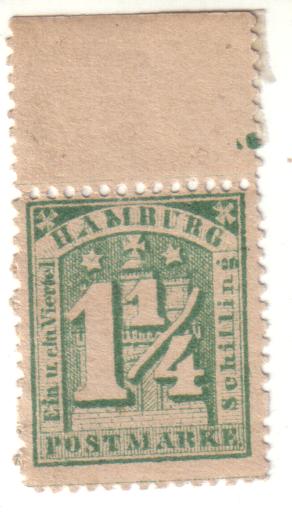

Goldner made reprints of the two above stamps of Hamburg. They don't have any watermark.
Note: on my website many of the
pictures can not be seen! They are of course present in the cd's;
contact me if you want to purchase them: evert@klaseboer.com.
Julius Goldner was a stamp dealer in Hamburg (Germany), who
sold enormous quantities of reprints of Hamburg, Helgoland and
forgeries of Bergedorf, Transvaal, Ecuador and Romagna (see
'Philatelic Forgers, their Lives and Works' by Varro Tyler).
Goldner was born in 1848 and died in 1898.
The Bund Deutscher Philatelisten mentions June 1842 and 14
January 1898 as dates when Goldner was born and died
respectively. According to this source he started dealing stamps
in Hamburg in the early 1860's. His three sons and his wife
continued his business after his death.
In 'The Day' newspaper of July 25, 1898, we can read: "Julius
Goldner, the wholesale dealer of Hamburg, whose death was
reported, is said to have made $500,000 during the 35 years he
was in the stamp business".
His business must have survived since "Julius Goldner,
Briefmarken-Großhandel, Hohe Bleichen 31/35" was
victim of the 'Kristalnacht' of 9 to 10 November 1938, in which
many Jewish businesses were destroyed (source: http://www.tagderjuedischenkultur.de/novemberprogrom/projekt.html).
Besides making 'reprints' he also acquired the remainders of the postal due stamps of Baden (see there) and many postage stamps of Prussia. He was also involved in making reprints of Prussia (source Paul Ohrt, Handbuch der Neudrucke).
For the specialist: these stamps have a watermark wavy lines. Reprints were made in 1872, but these reprints don't have any watermark are printed on yellowish paper and have thinner 'guidelines' between the stamps. Genuine stamps have perforation 13 1/2. Some reprints have perforation 11 1/2. The reprints exist in all kind of color shades (as the genuine stamps). They were made by the printer of the genuine stamps C.Adler of Hamburg and later sold by the stamp dealer Julius Goldner. At first the same perforation machines were used as for the genuine stamps, but later a new perforation machine which perforated the stamps 11 1/2 instead of 13 1/2 was used. A very small number of reprints on watermarked paper also exist. Goldner also ordered some reprints of non-existing essays (on unwatermarked paper) with the colors inverted, thus 1 1/4 s green and 2 1/2 s lilac. Furthermore some phantasy prints were made of both stamps in bogus colors. For a full description of the history of these reprints, see Ohrt, Handbuch der Neudrucke (in German).


Goldner made reprints of the two above stamps of Hamburg. They
don't have any watermark.

'Essay' reprint of a 1 1/4 Sch green

'Essay' reprints in various colors, made by Goldner.
Goldner acquired the remainders of Hamburg for 900 Thalers. He stored them in a damp place which spoilt the gum of many of them. These remainders were then later sold without gum (source: Bund Deutscher Philatelisten). A circular cancel with 'HAMBURG' and two stars on each side was used to cancel remainders (to increase the value of the stamp) of Hamburg which were acquired by Goldner. This cancel was only used as an arrival cancel on envelopes, but never to cancel stamps! So these stamps are genuine stamps with a fake cancel. However, the book 'Handbuch der Neudrucke' by Ohrt says on page 348 that these cancels themselves were also forged. According to Ohrt, the stars in the above forged cancels are much larger.

A mini sheet of 10 Goldner reprints with tete-beche stamps of the
1/2 Gr posthorn stamp of Hannover. Goldner reprints have a single
line instead of two lines as connection between the mouthpiece
and the horn. Reduced size. He also made reprints in sheets of 50
(10 x 5) with no tete-beche stamps.

Most likely a Goldner reprint of the 3 Pf stamp of Hanover.
Goldner produced also enormous quantities (millions) of reprints of Helgoland. See also http://www.fritzwagner.com/helgoland/goldner_and_his_reprints.html for more details.
The Permanentes Handbuch der Postfreimarkenkunde Erster Teil Deutsche Staaten, Abschnitt XIII: Preussen by Hugo Krötzsch (1896), page 121 (585) says that the second reprint of 1873 of the stamps of Prussia was initiated by Goldner. He paid a certain amount to the war victims fund in return for the reprints. See also Paul Ohrt's book 'Handbuch der Neudrucke'. Goldner also acquired previously the remainders of Prussia.
I've been told that the next forgery of Saxony was made by Goldner as well. I'm not sure if this information is correct.

(Could this be the forgeries described in 'The Spud Papers'?)

This forgery sold with some other stamps of Saxony for 1110 Euros
on Ebay (2008)!
The reprints of Transvaal, as made by the printer of the genuine stamps, Otto (Gustrow, Mecklenburg-Schwerin), were also sold by Goldner. Examples of such reprints: